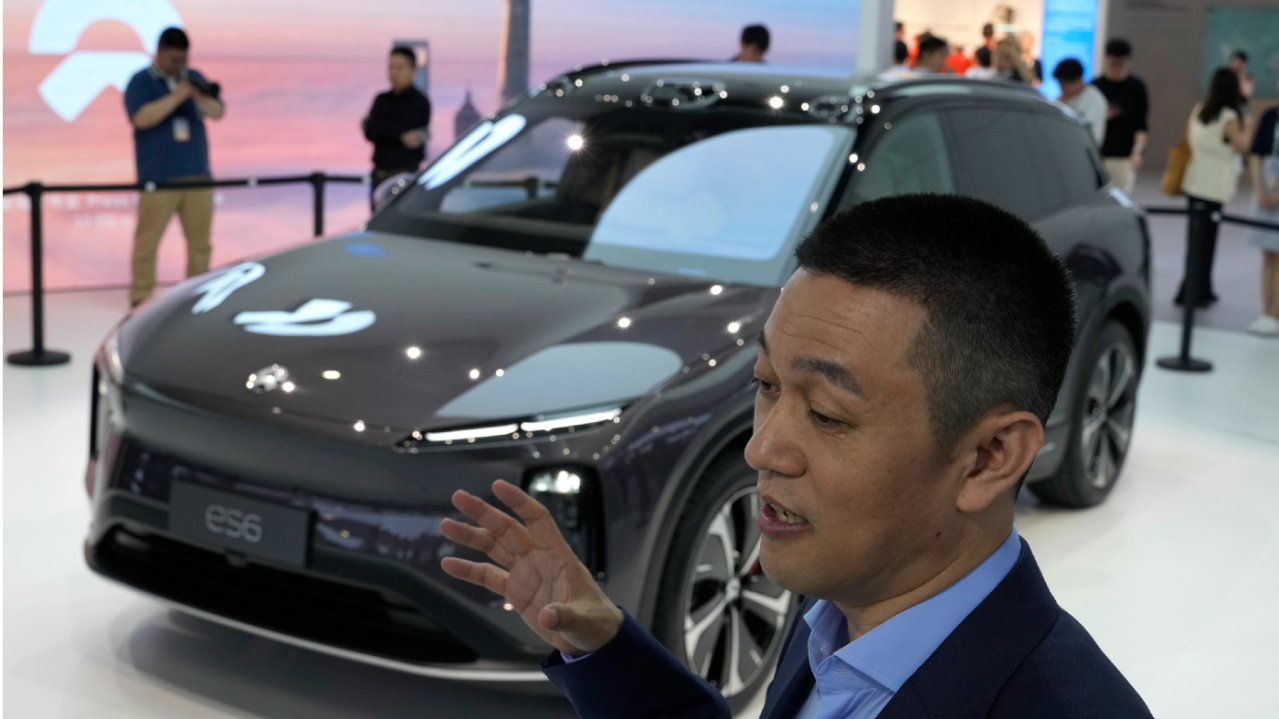Is America Falling Behind? Examining China's Electric Vehicle Strategy

Table of Contents
China's Comprehensive EV Strategy: A Multi-pronged Approach
China's dominance in the EV sector isn't accidental; it's the result of a meticulously planned, government-led initiative. Their strategy isn't simply about producing EVs; it's about controlling the entire value chain, from battery technology to charging infrastructure. This multi-pronged approach includes significant government investment and supportive policies aimed at fostering domestic EV manufacturers and accelerating adoption.
- Massive government investment in battery technology research and development: China has poured billions into research and development, leading to advancements in battery energy density and charging speeds, surpassing some Western competitors. This investment has fostered innovation and spurred the growth of domestic battery giants.
- Extensive charging station network construction across the country: Recognizing that widespread adoption requires convenient charging, China has invested heavily in building a robust national charging network, alleviating "range anxiety," a major obstacle to EV adoption. This infrastructure investment has been a key factor in the success of their EV strategy.
- Stricter emission regulations pushing consumers towards EVs: China's stringent emission standards have created a strong incentive for consumers to transition to EVs, significantly boosting demand. These regulations act as a powerful catalyst for market growth.
- Support for domestic EV manufacturers through preferential policies: Through subsidies, tax breaks, and other preferential policies, the Chinese government has nurtured the growth of domestic EV manufacturers like BYD and NIO, enabling them to compete effectively on a global scale. This protectionist approach has given domestic companies a significant advantage.
- Focus on developing a complete domestic supply chain for EV components: China aims to minimize its reliance on foreign suppliers by developing a robust domestic supply chain for all EV components, including batteries, motors, and electronics. This strategy reduces vulnerability to global supply chain disruptions and strengthens national security. This includes securing access to crucial rare earth minerals.
These combined efforts illustrate a cohesive China EV policy that prioritizes comprehensive development and control over the entire EV ecosystem.
The American EV Landscape: Challenges and Opportunities
The American EV market presents a contrasting picture. While significant progress is being made, challenges remain that hinder the United States from keeping pace with China's rapid advancements. Slower adoption rates, fragmented infrastructure, and reliance on foreign battery components are significant obstacles.
- Comparison of US government incentives with China's: While the US government offers tax credits and incentives for EV purchases, they are often less generous and less strategically targeted than China's extensive subsidies. This difference in approach affects the speed of market penetration.
- Analysis of the market share of domestic vs. foreign EV manufacturers in the US: While Tesla remains a prominent player, American manufacturers are facing stiff competition from established foreign brands, highlighting the need for stronger domestic support.
- Discussion of the challenges related to building a robust charging infrastructure: The US lags behind China in the development of a comprehensive nationwide charging network. Inconsistencies in standards and a lack of coordinated investment hamper progress.
- Examination of US policy on battery production and supply chain security: The US is increasingly focusing on bolstering domestic battery production and securing its supply chain, recognizing the strategic importance of battery technology in the EV sector and national security.
Technological Innovation: A Key Battleground
The race for EV dominance isn't just about policy; it's a battleground for technological innovation. Both China and the US are investing heavily in research and development, but the focus and approach differ.
- Comparison of battery energy density and charging times: While both countries are making progress, China's substantial investment in battery technology has yielded impressive results in terms of energy density and charging speed in some areas.
- Discussion of advancements in autonomous driving technology in both countries: Both nations are pushing boundaries in autonomous driving, but the regulatory environment and the approach to data collection and usage differ significantly.
- Analysis of intellectual property rights and technology transfer: Concerns about intellectual property protection and technology transfer are emerging as a key aspect of the competition.
- Focus on the role of research and development funding: Continued investment in research and development is crucial for both nations to maintain their competitiveness in this rapidly evolving field.
Geopolitical Implications of the EV Race
The global EV race has profound geopolitical implications, impacting resource control, manufacturing dominance, and national security.
- Discussion on the competition for rare earth minerals and battery materials: The competition for rare earth minerals and other critical battery materials is intensifying, creating geopolitical tensions and strategic dependencies.
- Analysis of the impact on global trade and manufacturing jobs: The shift towards EVs will reshape global trade patterns and impact manufacturing jobs in various countries.
- Examination of the national security implications of reliance on foreign EV technology: Over-reliance on foreign technology and supply chains poses a significant national security risk for many countries.
Conclusion
The differences between China's and America's approaches to electric vehicle development are stark. China's comprehensive, government-led strategy, encompassing substantial investment, robust infrastructure development, and a focus on domestic supply chains, presents a formidable challenge to the US. Concerns are legitimate about America potentially falling behind in this crucial sector. The US needs strategic investments, a unified and robust policy framework, and a commitment to technological innovation to maintain its competitiveness in the global EV market. The future of the automotive industry, and indeed global energy security, is deeply intertwined with the success of electric vehicle technology. Understanding China's aggressive electric vehicle strategy is crucial for the United States to develop and implement a winning electric vehicle strategy of its own. We need to actively engage in the discussion about how America can strengthen its electric vehicle strategy and reclaim its position as a global leader.

Featured Posts
-
 Cocaines Global Rise The Role Of Potent Powder And Narco Submarines
May 05, 2025
Cocaines Global Rise The Role Of Potent Powder And Narco Submarines
May 05, 2025 -
 Trumps Action Against Perkins Coie Struck Down By Judge
May 05, 2025
Trumps Action Against Perkins Coie Struck Down By Judge
May 05, 2025 -
 Analyzing The 2025 Louisiana Derby Odds Top Contenders And Road To Kentucky Derby
May 05, 2025
Analyzing The 2025 Louisiana Derby Odds Top Contenders And Road To Kentucky Derby
May 05, 2025 -
 Bookstore Unearths Rare Novel Worth 45 000
May 05, 2025
Bookstore Unearths Rare Novel Worth 45 000
May 05, 2025 -
 Holi Heatwave South Bengal Temperatures Hit Near 38 Degrees
May 05, 2025
Holi Heatwave South Bengal Temperatures Hit Near 38 Degrees
May 05, 2025
Latest Posts
-
 Ufc 314 Volkanovski Vs Lopes Full Fight Card And Predictions
May 05, 2025
Ufc 314 Volkanovski Vs Lopes Full Fight Card And Predictions
May 05, 2025 -
 Ufc 314 Card Damaged Highly Anticipated Knockout Match Called Off
May 05, 2025
Ufc 314 Card Damaged Highly Anticipated Knockout Match Called Off
May 05, 2025 -
 Causes Of Slow Traffic Movement In Darjeeling And Potential Improvements
May 05, 2025
Causes Of Slow Traffic Movement In Darjeeling And Potential Improvements
May 05, 2025 -
 Cancelled Fight Ufc 314 Suffers Major Setback
May 05, 2025
Cancelled Fight Ufc 314 Suffers Major Setback
May 05, 2025 -
 Ufc 314 Takes A Hit Knockout Artists Fight Cancelled
May 05, 2025
Ufc 314 Takes A Hit Knockout Artists Fight Cancelled
May 05, 2025
